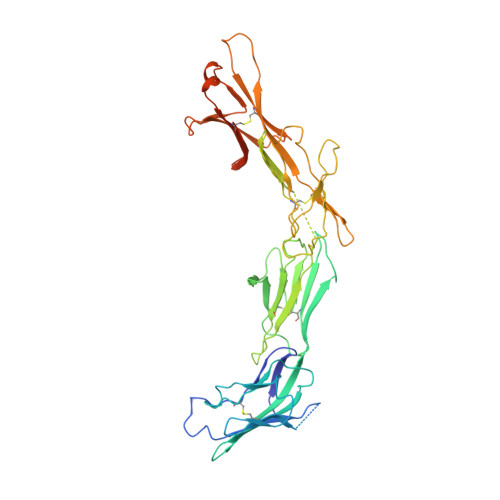Structural insights reveal interplay between LAG-3 homodimerization, ligand binding, and function.
Silberstein, J.L., Du, J., Chan, K.W., Frank, J.A., Mathews, I.I., Kim, Y.B., You, J., Lu, Q., Liu, J., Philips, E.A., Liu, P., Rao, E., Fernandez, D., Rodriguez, G.E., Kong, X.P., Wang, J., Cochran, J.R.(2024) Proc Natl Acad Sci U S A 121: e2310866121-e2310866121
- PubMed: 38483996
- DOI: https://doi.org/10.1073/pnas.2310866121
- Primary Citation of Related Structures:
8DGG - PubMed Abstract:
Lymphocyte activation gene-3 (LAG-3) is an inhibitory receptor expressed on activated T cells and an emerging immunotherapy target. Domain 1 (D1) of LAG-3, which has been purported to directly interact with major histocompatibility complex class II (MHCII) and fibrinogen-like protein 1 (FGL1), has been the major focus for the development of therapeutic antibodies that inhibit LAG-3 receptor-ligand interactions and restore T cell function. Here, we present a high-resolution structure of glycosylated mouse LAG-3 ectodomain, identifying that cis-homodimerization, mediated through a network of hydrophobic residues within domain 2 (D2), is critically required for LAG-3 function. Additionally, we found a previously unidentified key protein-glycan interaction in the dimer interface that affects the spatial orientation of the neighboring D1 domain. Mutation of LAG-3 D2 residues reduced dimer formation, dramatically abolished LAG-3 binding to both MHCII and FGL1 ligands, and consequentially inhibited the role of LAG-3 in suppressing T cell responses. Intriguingly, we showed that antibodies directed against D1, D2, and D3 domains are all capable of blocking LAG-3 dimer formation and MHCII and FGL-1 ligand binding, suggesting a potential allosteric model of LAG-3 function tightly regulated by dimerization. Furthermore, our work reveals unique epitopes, in addition to D1, that can be targeted for immunotherapy of cancer and other human diseases.
Organizational Affiliation:
Program in Immunology, Stanford University School of Medicine, Stanford, CA 94305.


















